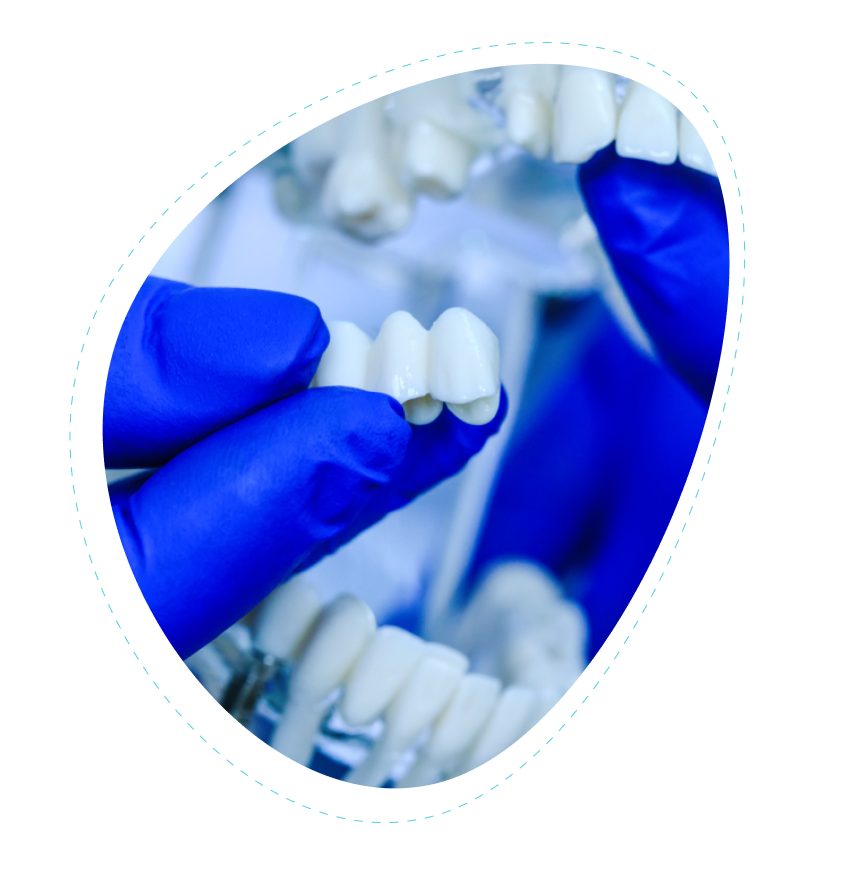Prosthodontists at FloMo Dental provide dental bridges for people with gaps between teeth. Dental bridges are artificial teeth that replace one or a row of missing teeth. We make permanent dental bridges in Flower Mound, TX, according to your natural teeth’ shape, shade, and structure.
As an alternative to partial dentures, permanent dental bridges are extremely durable. However, the condition and strength of the remaining teeth, especially the ones around the bridge, affect its stability. Before shortlisting and suggesting the type of dental bridge, our prosthodontists in Flower Mound, Texas, will evaluate your oral condition.
Why Should You Get a Dental Bridge?
One of the primary reasons people with missing teeth opt for dental bridges is to reinstate their tooth’s natural ability to perform routine functions. Some more reasons are;
- Maintain and improve the alignment of your teeth
- It is easy to maintain and crown
- Transform your smile into a perfect & healthy one
- Enhance your overall oral health
- It helps preserve your jawbone
The procedure of dental bridges depends upon its type, but if you feel or think that dental bridges can benefit you, call us at 469-933-0073 to schedule an appointment.

What is a Dental Bridge?
A dental bridge is a fixed prosthetic device that consists of one or more artificial teeth (called pontics) held in place by dental crowns on either side. These crowns are typically placed on the natural teeth adjacent to the gap, which act as anchors for the bridge.
Types of Dental Bridges
There are several types of dental bridges, including:
Traditional Bridges: The most common type, these involve creating crowns for the teeth on either side of the missing tooth, with a pontic in between.
Cantilever Bridges: Used when there are adjacent teeth on only one side of the missing tooth or teeth.
Maryland Bridges: These are less invasive and use a metal or porcelain framework bonded onto the backs of the adjacent teeth.
Implant-Supported Bridges: These are anchored by dental implants instead of natural teeth, offering superior stability.
The Dental Bridge Procedure
Getting a dental bridge typically involves several steps:
- Preparation of abutment teeth
- Taking impressions of the teeth
- Placement of a temporary bridge
- Creation of the permanent bridge in a dental lab
- Fitting and cementing of the permanent bridge
Benefits of Dental Bridges
Dental bridges offer numerous advantages:
- Restored ability to chew and speak properly
- Maintained face shape by preventing bone loss
- Proper distribution of bite force
- Prevention of remaining teeth from drifting out of position
- Enhanced aesthetic appearance
Caring for Your Dental Bridge
To ensure the longevity of your dental bridge:
- Practice excellent oral hygiene
- Avoid hard or sticky foods
- Use a floss threader or interdental brush to clean under the bridge
- Attend regular dental check-ups
Is a Dental Bridge Right for You?
Dental bridges are an excellent option for many people with missing teeth. However, they may not be suitable for everyone. Factors such as the health of your remaining teeth, the location of the missing tooth, and your overall oral health will determine if a bridge is the best solution for you.
Alternatives to consider include dental implants, which offer a more permanent solution, or partial dentures for those missing multiple teeth.
Consultation with a dentist is crucial to determine the best treatment plan for your specific needs. They can assess your oral health, discuss your options, and help you make an informed decision about whether a dental bridge is right for you.
Remember, replacing missing teeth is not just about aesthetics – it’s about maintaining your oral health and overall quality of life. Don’t hesitate to reach out to a dental professional to explore your options for restoring your smile.





